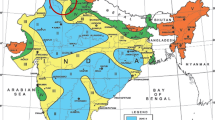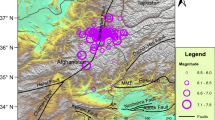Abstract
This study attempts to estimate the probability of the occurrence of large earthquakes (Mw ≥ 5.5) in the northwestern part of Haryana state, India, where a new nuclear power plant (NPP) is going to be constructed in the near future. First, an earthquake catalogue is developed for the period 1803–1986, and five stochastic models, namely lognormal, Weibull, gamma, Rayleigh, and double exponential, are then applied to past earthquake data. The performance of these models is checked using three statistical tests, and the lognormal, Weibull, and Rayleigh models are found to produce good approximations for this region, whereas the double exponential and gamma models yield intermediate and poor results. Hence, cumulative and conditional probabilities and related hazard curves for future earthquakes are estimated using the most suitable models. The cumulative probability of the occurrence of an earthquake (Mw ≥ 5.5) since the last event (1986) reached 0.95–0.98 as of 2018. The conditional probability of the occurrence of such an earthquake reaches 0.90–0.95 about 9–12 years from now (2027–2030), when the elapsed time will be 32 years (i.e., since 2018). The probability of earthquakes with different threshold magnitudes is then estimated, and based on the outcome of this investigation, earthquake magnitudes are classified from occasional (Mw ≤ 6.1) to very rare events (Mw ≥ 7.6) that this region may experience in the future. The findings of this study will be considered in seismic hazard assessment, liquefaction hazard assessment, and earthquake-resistant design of NPP components.









Similar content being viewed by others
References
AERB (Atomic Energy Regulatory Board). (1990). Seismic Studies and Design Basis Ground Motion for Nuclear Power Plant Sites. Standard AERB/SG/S-11, AERB.
Akaike, H. (1974). A new look at the statistical model identification. IEEE Transactions on Automatic Control,19(6), 716–723.
Ambraseys, N. (2000). Reappraisal of north-Indian earthquakes at the turn of the 20th century. Current Science,79(9), 1237–1250.
Ambraseys, N., & Bilham, R. (2000). A note on the Kangra Ms = 7.8 earthquake of 4 April 1905. Current Science,79(1), 45–50.
Ambraseys, N. N., & Douglas, J. (2004). Magnitude calibration of north Indian earthquakes. Geophysical Journal International,159(1), 165–206.
Chandra, U. (1977). Earthquakes of peninsular India—A seismotectonic study. Bulletin of the Seismological Society of America,67(5), 1387–1413.
Choudhury, D., & Shukla, J. (2011). Probability of occurrence and study of earthquake recurrence models for Gujarat state in India. Disaster Advances,4(2), 47–59.
Cornell, C. A. (1968). Engineering seismic risk analysis. Bulletin of the Seismological Society of America,58(5), 1583–1606.
Das, R., Sharma, M. L., Wason, H. R., Choudhury, D., & Gonzalez, G. (2019). A seismic moment magnitude scale. Bulletin of the Seismological Society of America,109(4), 1542–1555.
Das, R., Wason, H. R., Gonzalez, G., Sharma, M. L., Choudhury, D., Lindholm, C., et al. (2018). Earthquake magnitude conversion problem. Bulletin of the Seismological Society of America,108(4), 1995–2007.
Desai, S. S., & Choudhury, D. (2014). Earthquake catalogue for estimating seismic hazard at Greater Mumbai, India. Disaster Advances,7(10), 69–78.
ESRI. (2011). ArcGIS Desktop: Release 10. Redlands: Environmental Systems Research Institute (ESRI).
Ferraes, S. G. (2003). The conditional probability of earthquake occurrence and the next large earthquake in Tokyo. Journal of Seismology,7(2), 145–153.
Gardner, J. K., & Knopoff, L. (1974). Is the sequence of earthquakes in Southern California, with aftershocks removed, Poissonian? Bulletin of the Seismological Society of America,64(5), 1363–1367.
GSI. (2000). Seismotectonic Atlas of India and Its Environs. Kolkata: Geological Survey of India, Special Publication 59.
Gutenberg, B., & Richter, C. F. (1944). Frequency of earthquakes in California. Bulletin of the Seismological Society of America,34(4), 185–188.
Hagiwara, Y. (1974). Probability of earthquake occurrence as obtained from a Weibull distribution analysis of crustal strain. Tectonophysics,23(3), 313–318.
IS 1893-Part 1. (2016). Criteria for Earthquake Resistant Design Of Structures. New Delhi: Bureau of Indian Standards.
Iyengar, R. N., Sharma, D., & Siddiqui, J. M. (1999). Earthquake history of India in medieval times. Indian Journal of history of science,34(3), 181–238.
Johnson, N. L., Kotz, S., & Balakrishnan, N. (1995). Continuous Univariate Distributions, vol. 2 (2nd ed.). New York: Wiley.
Johnston, A. C., & Nava, S. J. (1985). Recurrence rates and probability estimates for the New Madrid seismic zone. Journal of Geophysical Research: Solid Earth,90(B8), 6737–6753.
Jordan, T. H. (2006). Earthquake predictability, brick by brick. Seismological Research Letters,77(1), 3–6.
Kiureghian, A. D., & Ang, A. H. (1977). A fault-rupture model for seismic risk analysis. Bulletin of the Seismological Society of America,67(4), 1173–1194.
Kolathayar, S., Sitharam, T. G., & Vipin, K. S. (2012). Spatial variation of seismicity parameters across India and adjoining areas. Natural Hazards,60(3), 1365–1379.
Kramer, S. L. (1996). Geotechnical Earthquake Engineering. New Jersey: Prentice Hall.
Matthews, M. V., Ellsworth, W. L., & Reasenberg, P. A. (2002). A Brownian model for recurrent earthquakes. Bulletin of the Seismological Society of America,92(6), 2233–2250.
Mogi, K. (1968). Sequential occurrences of recent great earthquakes. Journal of Physics of the Earth,16(1), 30–36.
Mosca, I., Console, R., & D’Addezio, G. (2012). Renewal models of seismic recurrence applied to paleoseismological and historical observations. Tectonophysics,564, 54–67.
Murthy, D. N. P., Xie, M., & Jiang, R. (2004). Weibull Models (2nd ed.). New Jersey: Wiley.
Naik, N., & Choudhury, D. (2014). Development of fault and seismicity maps for the state of Goa, India. Disaster Advances,7(6), 12–24.
NDMA. (2010). Development of probabilistic seismic hazard map of India. Technical report by National Disaster Management Authority, Government of India
Nishenko, S. P., & Buland, R. (1987). A generic recurrence interval distribution for earthquake forecasting. Bulletin of the Seismological Society of America,77(4), 1382–1399.
Ogawara, M. (1955). Probability of the coming felt earthquake in Tokyo. Quarterly Journal of Seismology.,20, 81–92.
Oldham, T. (1883). Catalogue of Indian Earthquakes. Memories Geological Survey of India,19, 163–215.
Parvez, I. A., & Ram, A. V. A. D. H. (1999). Probabilistic assessment of earthquake hazards in the Indian subcontinent. Pure and Applied Geophysics,154(1), 23–40.
Pasari, S. (2018). Stochastic modelling of earthquake interoccurrence times in Northwest Himalaya and adjoining regions. Geomatics, Natural Hazards and Risk,9(1), 568–588.
Pasari, S. (2019). Inverse Gaussian versus lognormal distribution in earthquake forecasting: keys and clues. Journal of Seismology,23, 1–23.
Pasari, S., & Dikshit, O. (2014a). Three-parameter generalized exponential distribution in earthquake recurrence interval estimation. Natural Hazards,73(2), 639–656.
Pasari, S., & Dikshit, O. (2014b). Impact of three-parameter Weibull models in probabilistic assessment of earthquake hazards. Pure and Applied Geophysics,171(7), 1251–1281.
Pasari, S., & Dikshit, O. (2015). Distribution of earthquake interevent times in northeast India and adjoining regions. Pure and Applied Geophysics,172(10), 2533–2544.
Rao, V. D., & Choudhury, D. (2018). Prediction of earthquake occurrence for a new nuclear power plant in India using probabilistic models. Innovative Infrastructure Solutions,3(1), 79.
Reid, H. F. (1911). The elastic rebound theory of earthquakes. Bulletin of the Department of Geology, University of Berkeley,6, 413–444.
Rikitake, T. (1991). Assessment of earthquake hazard in the Tokyo area, Japan. Tectonophysics,199(1), 121–131.
Rikitake, T. (1999). Probability of a great earthquake to recur in the Tokai district, Japan: Reevaluation based on newly-developed paleoseismology, plate tectonics, tsunami study, micro-seismicity and geodetic measurements. Earth, Planets and Space,51(3), 147–157.
Rundle, J. B., Turcotte, D. L., Shcherbakov, R., Klein, W., & Sammis, C. (2003). Statistical physics approach to understanding the multiscale dynamics of earthquake fault systems. Reviews of Geophysics,41(4), 1019.
SEAOC (Structural Engineers Association of California). (1995). Vision 2000—A framework for performance based design. Vision 2000 committee, California.
Tripathi, J. N. (2006). Probabilistic assessment of earthquake recurrence in the January 26, 2001 earthquake region of Gujrat, India. Journal of seismology,10(1), 119–130.
Utsu, T. (1972a). Large earthquakes near Hokkaido and the expectancy of the occurrence of a large earthquake off Nemuro. Report of the Coordinating Committee for Earthquake Prediction,7, 7–13.
Utsu, T. (1972b). Aftershocks and earthquake statistics (4): Analyses of the distribution of earthquakes in magnitude, time and space with special consideration to clustering characteristics of earthquake occurrence (2). Journal of the Faculty of Science, Hokkaido University. Series 7, Geophysics,4(1), 1–42.
Utsu, T. (1984). Estimation of parameters for recurrence models of earthquakes. Bulletin of the Earthquake Research Institute,59, 53–66.
Yadav, R. B. S., Tripathi, J. N., Rastogi, B. K., & Chopra, S. (2008). Probabilistic assessment of earthquake hazard in Gujarat and adjoining region of India. Pure and Applied Geophysics,165(9–10), 1813–1833.
Yadav, R. B. S., Tripathi, J. N., Rastogi, B. K., Das, M. C., & Chopra, S. (2010). Probabilistic assessment of earthquake recurrence in northeast India and adjoining regions. Pure and Applied Geophysics,167(11), 1331–1342.
Acknowledgements
The authors are grateful to the Board of Research in Nuclear Sciences, Department of Atomic Energy, Government of India, for providing financial support through grant number 36(2)/15/04/2016-BRNS/36004-36029 (16BRNS012) to carry out the research work presented in this paper. The authors would like to express their gratitude to the editor and anonymous reviewers for their valuable comments and thorough review of this manuscript, which has improved the quality significantly.
Author information
Authors and Affiliations
Corresponding author
Additional information
Publisher's Note
Springer Nature remains neutral with regard to jurisdictional claims in published maps and institutional affiliations.
Rights and permissions
About this article
Cite this article
Rao, V.D., Choudhury, D. Probabilistic Modelling for Earthquake Forecasting in the Northwestern Part of Haryana State, India. Pure Appl. Geophys. 177, 3073–3087 (2020). https://doi.org/10.1007/s00024-020-02418-y
Received:
Revised:
Accepted:
Published:
Issue Date:
DOI: https://doi.org/10.1007/s00024-020-02418-y




